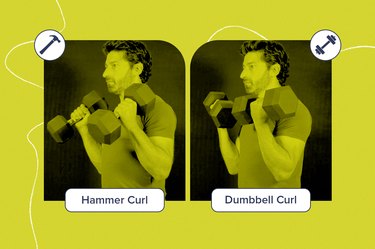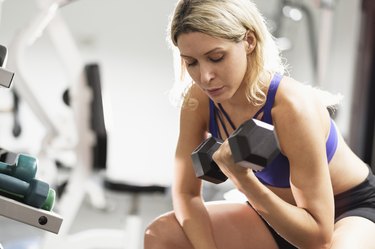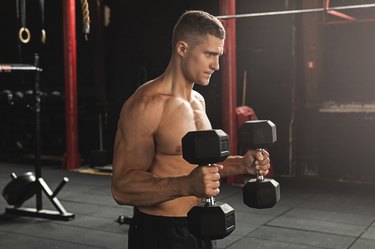
Biceps are the ultimate "show" muscles. And while they can be built with chin-ups, barbell rows, seated rows and more, most lifters chase an upper arm pump by grabbing a pair of dumbbells, standing in front of a mirror, and curling the weights to their shoulders.
"We all love to have a nice arm workout now and then, and biceps curls are definitely one of the fun, vanity moves to train," says Ryan Koziol, CSCS, certified strength and conditioning specialist and owner of RYKO Fitness.
By changing the position of your hands as you lift, though, you can change how curls challenge your arms during those fun sets. Turning your hands to face each other throughout the move turns a traditional curl into a hammer curl, a move that taxes your biceps, but also provides additional work for your forearms, elbow joint and a small muscle between your biceps and triceps called the brachialis.
But should you choose to do biceps curls or hammer curls, and is one better than the other? Let's get you armed and dangerous.
The Differences Between Hammer Curls and Biceps Curls
The main difference between these two arm exercises is the way the dumbbells are held. In a traditional biceps curl, your palms face up as you're lifting the weight. This is called a "supinated grip." Hammer curls use a "neutral grip," where your hands face each other throughout the movement.
This change in grip impacts how your arm muscles are taxed, and may make hammer curls slightly "easier" to complete than traditional curls if you don't have great grip strength. However, hammer curls also work more muscles, which can ultimately make them more challenging.
How Hammer Curls and Biceps Curls Work the Biceps
Both hammer curls and supinated biceps curls predominantly work the biceps brachii, what's more commonly known as the "biceps." This muscle has two heads, or parts, that originate from the shoulder joint. The heads extend down to the elbow, where they join together to form a single muscle belly. The biceps have two primary functions: to bend the elbow so that the hand comes toward the shoulder; and to rotate the forearm.
Classic biceps curls provide more challenge to the short head of the biceps. When you flex your arms in a traditional double biceps pose, the short head will make the biceps appear with more of a peak, looking like a baseball inside of the arm.
To see how this head gets activated in the supinated position, try this visual exercise from Brandon Lirio, CPT, certified personal trainer and director of Battleground Fitness. Hold one arm out in front of you with your palm facing in a neutral position, and your elbow barely bent. Look at your biceps.
"When I have a hammer grip like this, my heads are elongated all the way to the connector to the elbow," he says. In this position, you'll see that your biceps seems to stretch all the way into the cavity of your elbow joint.
But if you twist your forearm so that your palm faces up (as in a supinated curl) you'll see a little space form between the elbow crease and the biceps. "As I shift into this position, the biceps tendon immediately engages, and I will have muscular contraction to a small degree because it's preparing to do work."
The short, peaking head of the biceps is thus engaged right away in the supinated curl, and the longer head does less work. Because a hammer grip starts with the biceps in the elongated position, where the biceps is still lengthened all the way into the elbow crease, the hammer curl works the long head a little more.
In addition to its role in flexing the arm, the long head of the biceps is also involved in stability of the shoulder according to an August 2017 review in the Journal of Clinical Medicine Research. For this reason, says Jarrod Nobbe, CSCS, head weightlifting coach for the Athletic Lab Weightlifting team, the long head can be considered more of the "functional" head of the biceps, while the showy short head is more of the "fun" head.
But both curls work both heads, Lirio says. You can't completely shut off one head of the biceps, and you'll gain strength and size in both heads from both moves. The biceps curl just works the short head slightly more, and the hammer curl provides slightly more work to the long head.
How Hammer Curls and Biceps Curls Work Other Muscles in the Arm
Both of these curling moves also work two other muscles in the arm. In the forearm, these exercises challenge the brachioradialis, a muscle on the upper forearm. It's the muscle that makes your forearm look thick, but also functions in stabilizing your elbow and rotating the forearm. Hammer curls challenge this forearm muscle more than curls with an underhand grip.
Another muscle in the upper arm, the brachialis, also contributes when you perform hammer or supinated curls. If you're looking at the outside of your upper arm, the brachialis sits between the biceps and the triceps. This muscle contributes to flexing the elbow, and is worked slightly more during hammer curls than during regular biceps curls.
Hammer Curls May Feel “Easier”
You may find that you can perform hammer curls with more weight, or for more reps with the same weight, as you can with biceps curls.
Nobbe says the increased contribution by the brachioradialis and brachialis, as well as the long head of the biceps, while small, means more overall muscle mass is involved in moving the weight. This doesn't mean the biceps brachii isn't working, of course: In studies comparing different curl grips, like this one done with a cable machine for the March 2023 issue of Sports (Basel), scientists have not found a significant difference in how much the biceps are challenged by either hand position.
The second reason hammer curls may feel easier is the position of the wrist, Koziol says. The neutral position, he says, is more stable.
How to Do Biceps Curls With Correct Form
- Stand with your feet shoulder-width apart, holding dumbbells in front of your thighs, with your palms facing up. Squeeze your butt and flex your abs throughout the movement to keep yourself from swinging your hips.
- Keeping a proud chest, bend your elbows to bring your fists up to your shoulders.
- Return the weights back to the starting position at a controlled pace. Repeat.
Tip
You can also perform this move (or hammer curls) while seated on a flat bench, or leaning back on an incline bench. Incline curls are a bit more challenging, so use a little less weight.
How to Do Hammer Curls With Correct Form
- Stand with your feet shoulder-width apart holding dumbbells at your sides, with your palms facing each other. Squeeze your butt and flex your abs throughout the movement to keep yourself from swinging your hips.
- Keeping a proud chest, bend your elbows to bring the weights up to your shoulders. Your hands should remain in a neutral position throughout the movement.
- Return the weights back to the starting position at a controlled pace. Repeat.
Which Is Better?
In electromyographic studies like the one from 2023, which involve placing electrodes on muscles to see which are stimulated the most, scientists have not found statistically significant differences in the activation of biceps brachii between hammer curls and supinated biceps curls. So when it comes to building bigger biceps, neither move is "better," according to the averages produced in these studies.
But there are other reasons that one move might be better for you than the other, Lirio says. For starters, study results provide averages of effects among multiple people. Your results, and the way an exercise feels in your muscles, may be outside of those averages.
Your goals and injury history may also inform which move is preferable for you, Nobbe says. If you have a history of tennis elbow, hammer curls may feel better because there's more support for the elbow tendon from the other muscles involved.
If your goal is to emphasize the short head of the bicep, creating an epic peak, supinated curls may be "better" for you.
Finally, there's your preferences: Both moves tax the biceps, so choosing the move you like more may mean you're more likely to do it — and continue progressing toward your goals, whether that's strength or hypertrophy. If neither move hurts you or causes discomfort, the one you like may be better for you.
When to Do Hammer Curls
If you're more worried about building muscle all along your arms, the additional challenge to your forearm, brachialis and long head of the biceps can make hammer curls a great all-over mass builder, Nobbe says. The move may help you build bigger forearms and wider overall biceps.
Some other reasons you might choose to hammer some hammers:
- You want to use heavier weights: Many lifters find they can hammer curl with larger dumbbells than they can use for supinated curls. This can result in more overall volume to the biceps, says Lirio, including to the short head of the upper arm. Just be careful not to swing your body if you go heavier: Continue to lift and lower the weight under control to maximize the tension on the target muscles.
- • Your elbows or shoulders are uncomfortable: If you do lots of supinated biceps curls or chin-ups, you may experience some discomfort in your elbow tendons. And if you perform a lot of pressing motions, Koziol says, you can experience discomfort in the fronts of your shoulders. "In the supinated curl, you're demanding a lot of the biceps tendon, and you're eliminating the support groups of the brachioradialis and long head of the biceps [that are worked in hammer curls]," he says. In these cases, he says, you may be able to continue growing your upper arms without discomfort by switching to hammer curls.
- You just want to mix things up: For optimum growth, or hypertrophy, of a muscle group, it's recommended that lifters perform 10 to 15 sets of exercises that challenge that muscle per week, Shannon Cooper, CPFT, NordicTrack and iFIT trainer, says. If 15 sets of underhand curls isn't letting you maintain your intensity (or if it's just boring), hammer curls can provide variety that still challenges the biceps, she says.
When to Do Biceps Curls
If you're hyper-focused on building your biceps, or just want to isolate the biceps as much as possible, supinated biceps curls may be your preferred move.
Some other reasons to curl dumbbells with your palms facing up:
- You want a greater range of motion: When you hammer curl, the range of motion at the top of the move is restricted because the end of the dumbbell hits the front of your shoulder. This is especially true with larger, hexagonal dumbbells or adjustable dumbbell sets. Because your hands can almost reach your shoulder in a supinated curl, you can get a little more range of motion, and may feel more squeeze in the biceps at the top.
- You want to improve your chin-ups: Biceps curls don't have a ton of functional applications, Koziol says, and that's OK! You can do certain exercises just because they're fun, or for aesthetic reasons. But supinated biceps curls do mimic the movement and strength you'll need for underhand chin-ups, so they could help you improve on the bar.
4 Ways to Use Hammer Curls and Biceps Curls In Your Workouts
Just as whether hammer curls or biceps curls are "better" depends on you, how you'll want to use them depends on you, too, Cooper says.
"It depends on that particular person's goals, how they train, and how many times per week they're training," she says.
If you're choosing curls as part of your regimen, it's probably safe to assume that one of your goals is bigger, stronger biceps. Two different research reviews — one from June 2017 from the Journal of Sports Science, and another from January 2022 in the Journal of Human Kinetics — concluded that training a muscle group for 10 or more sets per week was optimal for hypertrophy, with added benefits for up to 20 weekly sets. In the studies scientists reviewed, a "hard set" was one where lifters came close to failing, but did not quite reach failure.
Basically, in each set, you want to leave 1 to 3 repetitions in the tank, and do 10 or more sets of this kind each week. Here are four options for using these two moves that can help you reach these goals.
Option 1: Use Both Curls in the Same Day
If you're only lifting a few times per week, and each session is a total-body workout, you may want to use both hammer curls and supinated curls in the same workout, Cooper says. Perform 2 to 4 sets of one variety, then 2 to 4 sets of the other curl. Repeat this in your next total body session later in the week.
Option 2: Alternate the Moves Every Other Workout
If you're training upper body pulling motions two or three times per week, or if you're doing total body sessions three or four per week, you can alternate hammer and biceps curls in each workout, Koziol says. In your first session, you might perform 4 sets of supinated curls. In the next session, you'd swap that for 4 sets of hammer curls.
Option 3: Use a Curl That’s Different From Your Other Pulling Movements
Your biceps aren't just worked by curls, Nobbe points out. You're also training them if you're performing multi-joint pulling movements like pull-ups, barbell rows, seated cable rows or any other rowing motion.
In these cases, he suggests, it may make your arm-building more well-rounded to choose a curl variation that's different from the hand position you used in most of your other pulling movements. So if you do chin-ups with a supinated grip in one workout, try some hammer curls in that session to get a little more stress on the long head of your bicep. If you're performing neutral-grip seated cable rows or T-bar rows, do supinated curls to challenge yourself in a palms-up position.
Option 4: Mix Them in a Finisher for a Huge Pump
One way bodybuilders try to increase the amount of work they do with a muscle — called volume — to gain more muscle is called a drop set. To do a drop set, you perform a set of an exercise with one weight that is fatiguing, then immediately reduce the weight (dropping it) to continue for more repetitions. You can continue dropping the weight in a third set, a fourth set, and beyond: When doing this with dumbbell curls, lifters call this "running the rack."
When trying to amp up volume for competition, Lirio says he likes to do drop sets that combine hammer curls with supinated dumbbell curls. He'll start with a hammer curl, because he can do it with a heavier weight. When his arms get fatigued, he'll drop down and immediately do supinated curls with a lighter weight.
"I'm engaging the head on the outside of the bicepsat the beginning with the hammer curls. And then I can burn out both heads separately, instead of just trying to burn out biceps equally during the set itself," he says. Doing the drop set this way, he says, "make the drop set more apt to actually give you results as opposed to just building up a lot of lactic acid."
Try it at the end of your next biceps workout: Do a fatiguing set of hammers, then drop down for supinated curls until you can't do any more.


